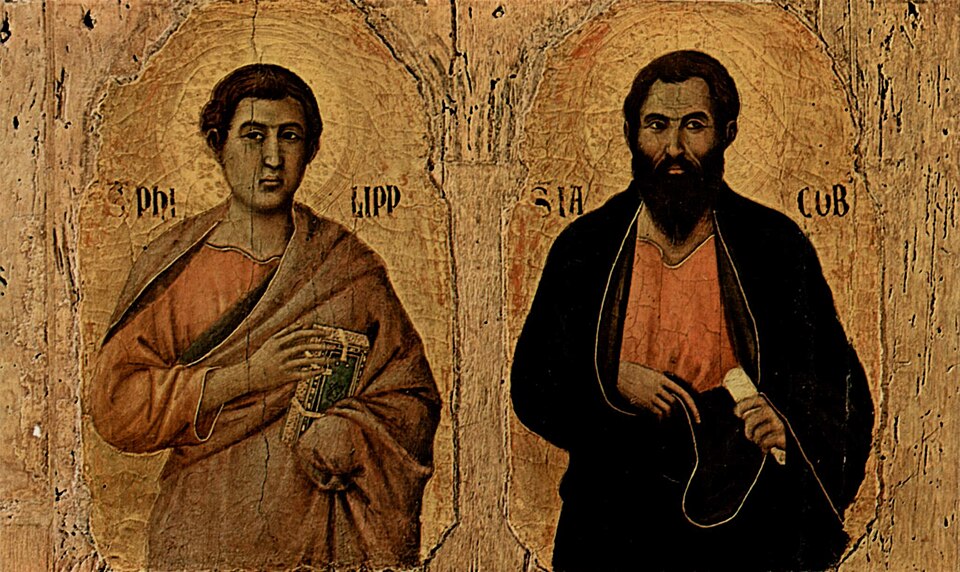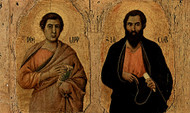Burial Place of Two Apostles in Rome
Posted by Pam - Merchant of Prato on May 14th 2025
I don’t know how many times I have visited Rome, but each time I discover new places that I have never seen before. I think you could probably spend a lifetime in Rome and never see all the sights.
A few months ago, I was in Rome with my tour book in hand and all the locations I had yet to see marked. One was the Basilica Santi XII Apostoli (The Basilica of the Twelve Holy Apostles), which is the final resting place of the Apostle James The Less and the Apostle Philip. In the past, I had visited the Tomb of St. Peter’s located under St. Peter’s Basilica and the Tomb of St. Paul in the under the main altar in the Basilica of St. Paul Outside-the-Walls. So, to be able to see the burial site of two more apostles was definitely something I desired to do.

St. James, known as James the Less served as the first bishop of Jerusalem, where he was eventually martyred being thrown from the roof of the Temple, and since he was still alive, then beaten and stoned to death. James was the first apostle to die for his Christian faith. Tradition states that James was buried on the Mount of Olives, overlooking Jerusalem. Roman Emperor Justinian II moved the remains of James the Less during the 6th century to Constantinople and at some point, a portion or perhaps all of St. James’ relics were moved to the Basilica of the Twelve Apostles in Rome, where today they lie in the same shrine with the relics of his fellow apostle, St. Philip.
St. Philip met a similar cruel death. Initially Philip was a follower of John the Baptist and later became an apostle of Jesus, listed in the Gospels as the fifth Apostle. After the crucifixion of Jesus, Philip left Jerusalem and spread Christianity throughout Greece, Syria and Phrygia. In 80AD, Emperor Domitian had Philip arrested in Hierapolis, Turkey where tradition states Philip was crucified upside down and eventually beheaded.
The site of St. Philip’s grave immediately became an important pilgrimage site for early Christians. In 2011, archaeologists working in Turkey announced that they had discovered what they believed to be the original tomb of St. Philip. They discovered a first century Roman sarcophagus within the ruins of a 4th or 5th century church dedicated to the apostle. This church had been destroyed in the 7th century by an earthquake. At which time, the remains of St. Philip were moved first to Constantinople and soon after to Rome where they were enshrined with the remains of St. James in the Basilica of the Twelve Apostles.

A church has existed on the site of The Basilica of the Twelve Apostles from as early as the 4th century. In the 6th century, the earlier church was rebuilt and dedicated to Philip and James the Less when their relics were brought here from the East. Later the church was dedicated to all the apostles.
Commonly known as Santi Apostoli, the church is a minor basilica in Rome, Italy and the mother church of the Conventual Franciscan Order, who are dedicated to living a life of prayer and service in the spirit of their founder, St. Francis of Assisi, and are known for their ministry to the poor and marginalized. The first church on this spot was built by Pope Julius I in the mid-4th century. The succeeding church was constructed by Pope Pelagius I in 552. In 570, the church was dedicated by Pope John III to the Apostles St. James the Less and St. Philip. In 1348, Santi Apostoli was severely damaged by an earthquake and left abandoned.
In 1417, Pope Martin V, whose family owned the adjacent Palazzo Colonna, restored the church. By 1463, The Franciscans were put in charge of the church. Further restorations were completed by Pope Sixtus IV in the late 1400’s. And the year 1700, Pope Clement XI dramatically renovated the church and added a Baroque façade to the exterior.
The Basilica of the Twelve Apostles was also the parish church of Michelangelo when he lived in Rome. When he died, Michelangelo was buried here. Later his body was moved, or some say stolen, to Florence where he was reburied in the Basilica of Santa Croce.
In 2016, the Vatican gave the Franciscan Friars Conventual permission to open the tombs of the two apostles. Among the items inside were discovered the foot of St. Philip and the femur of St. James. The Gospels state that Jesus washed the foot of Philip at the Last Supper. This foot also clearly shows evidence that it had been pierced. Philip was crucified and his foot would have been pierced by a nail. The foot which is over 2,000 years old is described as including "mummified soft tissue," which suggests a state of preservation. The foot of Philip and the femur of James the Less both should have decomposed a very long time ago, but both are still in tack, with the foot still having some tissue remaining.
To view the tombs of St. James the Less and St, Philip in Rome, visit the Basilica dei Santi Apostoli (Church of the Holy Apostles). The tombs are located under the altar of the basilica.
Go to the Crypt down a double horseshoe shaped marble staircase to venerate the relics of the Apostles Philip and James the Less. Here you will find a large semicircular area, which leads into a small chapel. Beyond the grate, you will see a marble sarcophagus, where the relics of the two holy apostles reside.
St. Philip's foot and St. James' femur are located right under the altar. They lie perfectly in line with their bodies.

